Genus Varanus Scientific name Varanus komodoensis Higher classification Monitor lizard | Phylum Chordata Family Varanidae Subgenus Varanus Conservation status Vulnerable Clutch size 20 | |
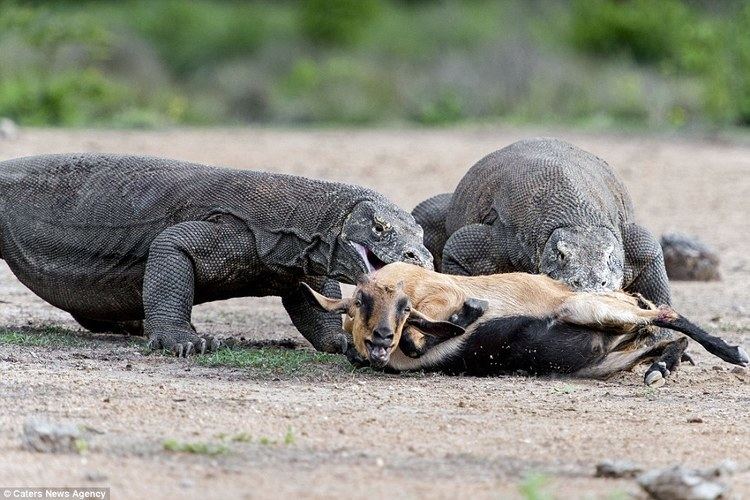 | ||
Mass Male: 79 – 91 kg (Adult), Female: 68 – 73 kg (Adult) Length Male: 2.6 m (Adult), Female: 2.3 m (Adult) Similar Monitor lizard, Lizard, Reptile, Varanidae, Common Iguanas | ||
Largest lizard on earth the komodo dragon deadly 60 indonesia series 3 bbc
The Komodo dragon (Varanus komodoensis), also known as the Komodo monitor, is a large species of lizard found in the Indonesian islands of Komodo, Rinca, Flores, Gili Motang, and Padar. A member of the monitor lizard family Varanidae, it is the largest living species of lizard, growing to a maximum length of 3 metres (10 ft) in rare cases and weighing up to approximately 70 kilograms (150 lb).
Contents
- Largest lizard on earth the komodo dragon deadly 60 indonesia series 3 bbc
- Etymology
- Evolutionary history
- Description
- Senses
- Behaviour and ecology
- Diet
- Saliva
- Venom
- Reproduction
- Parthenogenesis
- Discovery by the Western world
- Studies
- Conservation
- In captivity
- References
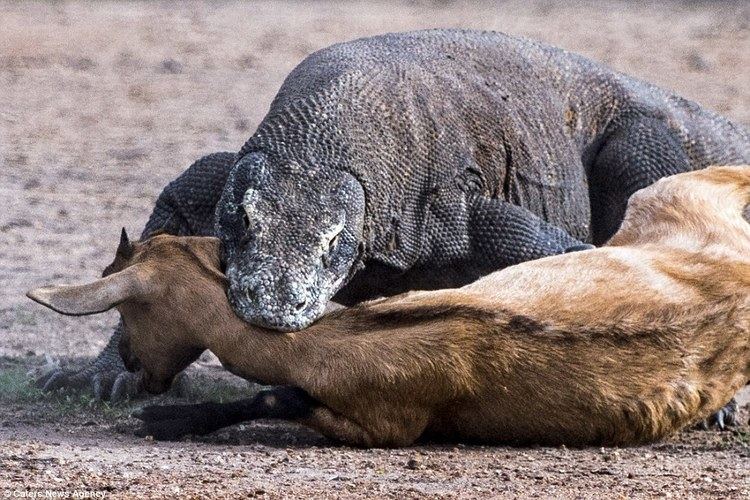
Their unusually large size has been attributed to island gigantism, since no other carnivorous animals fill the niche on the islands where they live. However, recent research suggests the large size of Komodo dragons may be better understood as representative of a relict population of very large varanid lizards that once lived across Indonesia and Australia, most of which, along with other megafauna, died out after the Pleistocene. Fossils very similar to V. komodoensis have been found in Australia dating to greater than 3.8 million years ago, and its body size remained stable on Flores, one of the handful of Indonesian islands where it is currently found, over the last 900,000 years, "a time marked by major faunal turnovers, extinction of the island's megafauna, and the arrival of early hominids by 880 ka [kiloannums]."
As a result of their size, these lizards dominate the ecosystems in which they live. Komodo dragons hunt and ambush prey including invertebrates, birds, and mammals. It has been claimed that they have a venomous bite; there are two glands in the lower jaw which secrete several toxic proteins. The biological significance of these proteins is disputed, but the glands have been shown to secrete an anticoagulant. Komodo dragon group behaviour in hunting is exceptional in the reptile world. The diet of big Komodo dragons mainly consists of deer, though they also eat considerable amounts of carrion. Komodo dragons also occasionally attack humans.
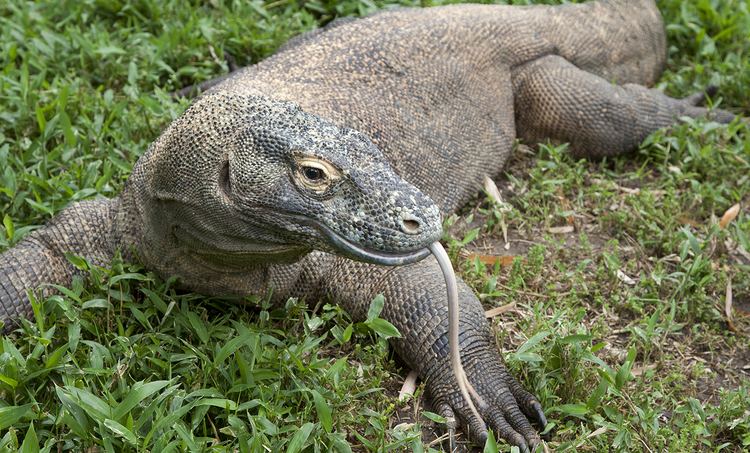
Mating begins between May and August, and the eggs are laid in September. About 20 eggs are deposited in abandoned megapode nests or in a self-dug nesting hole. The eggs are incubated for seven to eight months, hatching in April, when insects are most plentiful. Young Komodo dragons are vulnerable and therefore dwell in trees, safe from predators and cannibalistic adults. They take 8 to 9 years to mature, and are estimated to live up to 30 years.
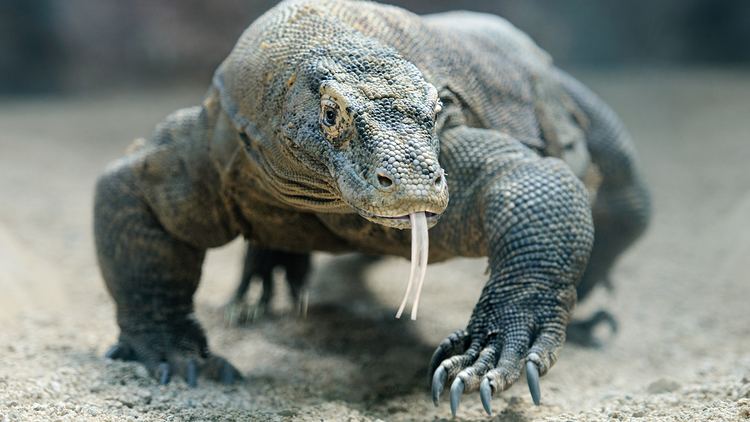
Komodo dragons were first recorded by Western scientists in 1910. Their large size and fearsome reputation make them popular zoo exhibits. In the wild, their range has contracted due to human activities, and they are listed as vulnerable by the IUCN. They are protected under Indonesian law, and a national park, Komodo National Park, was founded to aid protection efforts.

Etymology
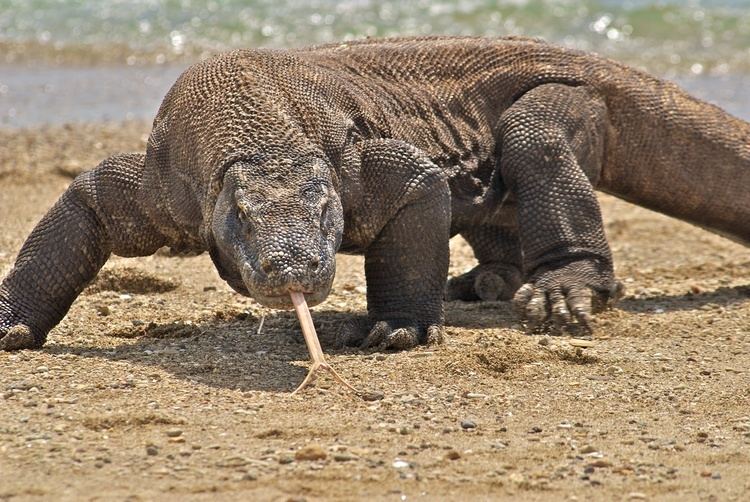
The Komodo dragon is also known as the Komodo monitor or the Komodo Island monitor in scientific literature, although this is not very common. To the natives of Komodo Island, it is referred to as ora, buaya darat (land crocodile), or biawak raksasa (giant monitor).
Evolutionary history
The evolutionary development of the Komodo dragon started with the Varanus genus, which originated in Asia about 40 million years ago and migrated to Australia, where it evolved into giant forms (the largest of all being the recently extinct Megalania), helped by the absence of competing placental carnivorans. Around 15 million years ago, a collision between Australia and Southeast Asia allowed these larger varanids to move back into what is now the Indonesian archipelago, extending their range as far east as the island of Timor. The Komodo dragon was believed to have differentiated from its Australian ancestors 4 million years ago. However, recent fossil evidence from Queensland suggests the Komodo dragon actually evolved in Australia before spreading to Indonesia. Dramatic lowering of sea level during the last glacial period uncovered extensive stretches of continental shelf that the Komodo dragon colonised, becoming isolated in their present island range as sea levels rose afterwards.
Description
In the wild, an adult Komodo dragon usually weighs around 70 kg (150 lb), although captive specimens often weigh more. According to the Guinness Book of World Records, an average adult male will weigh 79 to 91 kg (174 to 201 lb) and measure 2.59 m (8.5 ft), while an average female will weigh 68 to 73 kg (150 to 161 lb) and measure 2.29 m (7.5 ft). The largest verified wild specimen was 3.13 m (10.3 ft) long and weighed 166 kg (366 lb), including undigested food. The Komodo dragon has a tail as long as its body, as well as about 60 frequently replaced, serrated teeth that can measure up to 2.5 cm (1 in) in length. Its saliva is frequently blood-tinged, because its teeth are almost completely covered by gingival tissue that is naturally lacerated during feeding. It also has a long, yellow, deeply forked tongue. Komodo dragon skin is reinforced by armoured scales, which contain tiny bones called osteoderms that function as a sort of natural chain-mail. This rugged hide makes Komodo dragon skin poorly suited for making into leather.
Senses
As with other varanids, Komodo dragons have only a single ear bone, the stapes, for transferring vibrations from the tympanic membrane to the cochlea. This arrangement means they are likely restricted to sounds in the 400 to 2,000 hertz range, compared to humans who hear between 20 and 20,000 hertz. It was formerly thought to be deaf when a study reported no agitation in wild Komodo dragons in response to whispers, raised voices, or shouts. This was disputed when London Zoological Garden employee Joan Proctor trained a captive specimen to come out to feed at the sound of her voice, even when she could not be seen.
The Komodo dragon can see objects as far away as 300 m (980 ft), but because its retinas only contain cones, it is thought to have poor night vision. It can see in colour, but has poor visual discrimination of stationary objects.
The Komodo dragon uses its tongue to detect, taste, and smell stimuli, as with many other reptiles, with the vomeronasal sense using the Jacobson's organ, rather than using the nostrils. With the help of a favorable wind and its habit of swinging its head from side to side as it walks, a Komodo dragon may be able to detect carrion from 4–9.5 km (2.5–5.9 mi) away. It only has a few taste buds in the back of its throat. Its scales, some of which are reinforced with bone, have sensory plaques connected to nerves to facilitate its sense of touch. The scales around the ears, lips, chin, and soles of the feet may have three or more sensory plaques.
Behaviour and ecology
The Komodo dragon prefers hot and dry places, and typically lives in dry, open grassland, savanna, and tropical forest at low elevations. As an ectotherm, it is most active in the day, although it exhibits some nocturnal activity. Komodo dragons are solitary, coming together only to breed and eat. They are capable of running rapidly in brief sprints up to 20 km/h (12 mph), diving up to 4.5 m (15 ft), and climbing trees proficiently when young through use of their strong claws. To catch out-of-reach prey, the Komodo dragon may stand on its hind legs and use its tail as a support. As it matures, its claws are used primarily as weapons, as its great size makes climbing impractical.
For shelter, the Komodo dragon digs holes that can measure from 1 to 3 m (3.3 to 9.8 ft) wide with its powerful forelimbs and claws. Because of its large size and habit of sleeping in these burrows, it is able to conserve body heat throughout the night and minimise its basking period the morning after. The Komodo dragon hunts in the afternoon, but stays in the shade during the hottest part of the day. These special resting places, usually located on ridges with cool sea breezes, are marked with droppings and are cleared of vegetation. They serve as strategic locations from which to ambush deer.
Diet
Komodo dragons are carnivores. Although they eat mostly carrion, they will also ambush live prey with a stealthy approach. When suitable prey arrives near a dragon's ambush site, it will suddenly charge at the animal and go for the underside or the throat. It is able to locate its prey using its keen sense of smell, which can locate a dead or dying animal from a range of up to 9.5 km (5.9 mi). Komodo dragons have been observed knocking down large pigs and deer with their strong tails.
Komodo dragons eat by tearing large chunks of flesh and swallowing them whole while holding the carcass down with their forelegs. For smaller prey up to the size of a goat, their loosely articulated jaws, flexible skulls, and expandable stomachs allow them to swallow prey whole. The vegetable contents of the stomach and intestines are typically avoided. Copious amounts of red saliva the Komodo dragons produce help to lubricate the food, but swallowing is still a long process (15–20 minutes to swallow a goat). A Komodo dragon may attempt to speed up the process by ramming the carcass against a tree to force it down its throat, sometimes ramming so forcefully, the tree is knocked down. A small tube under the tongue that connects to the lungs allows it to breathe while swallowing. After eating up to 80% of its body weight in one meal, it drags itself to a sunny location to speed digestion, as the food could rot and poison the dragon if left undigested for too long. Because of their slow metabolism, large dragons can survive on as few as 12 meals a year. After digestion, the Komodo dragon regurgitates a mass of horns, hair, and teeth known as the gastric pellet, which is covered in malodorous mucus. After regurgitating the gastric pellet, it rubs its face in the dirt or on bushes to get rid of the mucus, suggesting it does not relish the scent of its own excretions.
The largest animals eat first, while the smaller ones follow a hierarchy. The largest male asserts his dominance and the smaller males show their submission by use of body language and rumbling hisses. Dragons of equal size may resort to "wrestling". Losers usually retreat, though they have been known to be killed and eaten by victors.
The Komodo dragon's diet is wide-ranging, and includes invertebrates, other reptiles (including smaller Komodo dragons), birds, bird eggs, small mammals, monkeys, wild boar, goats, deer, horses, and water buffalo. Young Komodos will eat insects, eggs, geckos, and small mammals. Occasionally, they attack and bite humans (see first paragraphs of this article). Sometimes they consume human corpses, digging up bodies from shallow graves. This habit of raiding graves caused the villagers of Komodo to move their graves from sandy to clay ground and pile rocks on top of them to deter the lizards. The Komodo dragon may have evolved to feed on the extinct dwarf elephant Stegodon that once lived on Flores, according to evolutionary biologist Jared Diamond.
The Komodo dragon drinks by sucking water into its mouth via buccal pumping (a process also used for respiration), lifting its head, and letting the water run down its throat.
Saliva
Although previous studies proposed that Komodo dragon saliva contains a variety of highly septic bacteria that would help to bring down prey, research in 2013 suggested that the bacteria in the mouths of Komodo dragons are ordinary and similar to those found in other carnivores. They actually have surprisingly good mouth hygiene. As Bryan Fry put it: "After they are done feeding, they will spend 10 to 15 minutes lip-licking and rubbing their head in the leaves to clean their mouth... Unlike people have been led to believe, they do not have chunks of rotting flesh from their meals on their teeth, cultivating bacteria." The observation of prey dying of sepsis would then be explained by the natural instinct of water buffalos, who are not native to the islands where the Komodo dragon lives, to run into water when attacked. The warm, faeces-filled water would then cause the infections. The study used samples from 16 captive dragons (10 adults and six neonates) from three U.S. zoos.
Venom
In late 2005, researchers at the University of Melbourne speculated the perentie (Varanus giganteus), other species of monitors, and agamids may be somewhat venomous. The team believes the immediate effects of bites from these lizards were caused by mild envenomation. Bites on human digits by a lace monitor (V. varius), a Komodo dragon, and a spotted tree monitor (V. scalaris) all produced similar effects: rapid swelling, localised disruption of blood clotting, and shooting pain up to the elbow, with some symptoms lasting for several hours.
In 2009, the same researchers published further evidence demonstrating Komodo dragons possess a venomous bite. MRI scans of a preserved skull showed the presence of two glands in the lower jaw. The researchers extracted one of these glands from the head of a terminally ill dragon in the Singapore Zoological Gardens, and found it secreted several different toxic proteins. The known functions of these proteins include inhibition of blood clotting, lowering of blood pressure, muscle paralysis, and the induction of hypothermia, leading to shock and loss of consciousness in envenomated prey. As a result of the discovery, the previous theory that bacteria were responsible for the deaths of Komodo victims was disputed.
Other scientists have stated that this allegation of venom glands "has had the effect of underestimating the variety of complex roles played by oral secretions in the biology of reptiles, produced a very narrow view of oral secretions and resulted in misinterpretation of reptilian evolution". According to these scientists "reptilian oral secretions contribute to many biological roles other than to quickly dispatch prey". These researchers concluded that, "Calling all in this clade venomous implies an overall potential danger that does not exist, misleads in the assessment of medical risks, and confuses the biological assessment of squamate biochemical systems". Evolutionary biologist Schwenk says that even if the lizards have venom-like proteins in their mouths they may be using them for a different function, and he doubts venom is necessary to explain the effect of a Komodo dragon bite, arguing that shock and blood loss are the primary factors.
Reproduction
Mating occurs between May and August, with the eggs laid in September. During this period, males fight over females and territory by grappling with one another upon their hind legs, with the loser eventually being pinned to the ground. These males may vomit or defecate when preparing for the fight. The winner of the fight will then flick his long tongue at the female to gain information about her receptivity. Females are antagonistic and resist with their claws and teeth during the early phases of courtship. Therefore, the male must fully restrain the female during coitus to avoid being hurt. Other courtship displays include males rubbing their chins on the female, hard scratches to the back, and licking. Copulation occurs when the male inserts one of his hemipenes into the female's cloaca. Komodo dragons may be monogamous and form "pair bonds", a rare behavior for lizards.
Female Komodos lay their eggs from August to September and may use several types of locality; in one study, 60% laid their eggs in the nests of orange-footed scrubfowl (a moundbuilder or megapode), 20% on ground level and 20% in hilly areas. The females make many camouflage nests/holes to prevent other dragons from eating the eggs. Clutches contain an average of 20 eggs, which have an incubation period of 7–8 months. Hatching is an exhausting effort for the neonates, which break out of their eggshells with an egg tooth that falls off soon after. After cutting themselves out, the hatchlings may lie in their eggshells for hours before starting to dig out of the nest. They are born quite defenseless and are vulnerable to predation. Sixteen youngsters from a single nest were on average 46.5 cm long and weighed 105.1 grams.
Young Komodo dragons spend much of their first few years in trees, where they are relatively safe from predators, including cannibalistic adults, as juvenile dragons make up 10% of their diets. The habit of cannibalism may be advantageous in sustaining the large size of adults, as medium-sized prey on the islands is rare. When the young approach a kill, they roll around in faecal matter and rest in the intestines of eviscerated animals to deter these hungry adults. Komodo dragons take approximately 8 to 9 years to mature, and may live for up to 30 years.
Parthenogenesis
A Komodo dragon at London Zoo named Sungai laid a clutch of eggs in late 2005 after being separated from male company for more than two years. Scientists initially assumed she had been able to store sperm from her earlier encounter with a male, an adaptation known as superfecundation. On 20 December 2006, it was reported that Flora, a captive Komodo dragon living in the Chester Zoo in England, was the second known Komodo dragon to have laid unfertilised eggs: she laid 11 eggs, and seven of them hatched, all of them male. Scientists at Liverpool University in England performed genetic tests on three eggs that collapsed after being moved to an incubator, and verified Flora had never been in physical contact with a male dragon. After Flora's eggs' condition had been discovered, testing showed Sungai's eggs were also produced without outside fertilization. On 31 January 2008, the Sedgwick County Zoo in Wichita, Kansas, became the first zoo in the Americas to document parthenogenesis in Komodo dragons. The zoo has two adult female Komodo dragons, one of which laid about 17 eggs on 19–20 May 2007. Only two eggs were incubated and hatched due to space issues; the first hatched on 31 January 2008, while the second hatched on 1 February. Both hatchlings were males.
Komodo dragons have the ZW chromosomal sex-determination system, as opposed to the mammalian XY system. Male progeny prove Flora's unfertilised eggs were haploid (n) and doubled their chromosomes later to become diploid (2n) (by being fertilised by a polar body, or by chromosome duplication without cell division), rather than by her laying diploid eggs by one of the meiosis reduction-divisions in her ovaries failing. When a female Komodo dragon (with ZW sex chromosomes) reproduces in this manner, she provides her progeny with only one chromosome from each of her pairs of chromosomes, including only one of her two sex chromosomes. This single set of chromosomes is duplicated in the egg, which develops parthenogenetically. Eggs receiving a Z chromosome become ZZ (male); those receiving a W chromosome become WW and fail to develop, meaning that only males are produced by parthenogenesis in this species.
It has been hypothesised that this reproductive adaptation allows a single female to enter an isolated ecological niche (such as an island) and by parthenogenesis produce male offspring, thereby establishing a sexually reproducing population (via reproduction with her offspring that can result in both male and female young). Despite the advantages of such an adaptation, zoos are cautioned that parthenogenesis may be detrimental to genetic diversity.
Discovery by the Western world
Komodo dragons were first documented by Europeans in 1910, when rumors of a "land crocodile" reached Lieutenant van Steyn van Hensbroek of the Dutch colonial administration. Widespread notoriety came after 1912, when Peter Ouwens, the director of the Zoological Museum at Bogor, Java, published a paper on the topic after receiving a photo and a skin from the lieutenant, as well as two other specimens from a collector. The first two live Komodo dragons to arrive in Europe were exhibited in the Reptile House at London Zoo when it opened in 1927. Joan Beauchamp Procter made some of the earliest observations of these animals in captivity and she demonstrated the behaviour of one of these animals at a Scientific Meeting of the Zoological Society of London in 1928. The Komodo dragon was the driving factor for an expedition to Komodo Island by W. Douglas Burden in 1926. After returning with 12 preserved specimens and 2 live ones, this expedition provided the inspiration for the 1933 movie King Kong. It was also Burden who coined the common name "Komodo dragon." Three of his specimens were stuffed and are still on display in the American Museum of Natural History.
Studies
The Dutch, realizing the limited number of individuals in the wild, outlawed sport hunting and heavily limited the number of individuals taken for scientific study. Collecting expeditions ground to a halt with the occurrence of World War II, not resuming until the 1950s and 1960s, when studies examined the Komodo dragon's feeding behavior, reproduction, and body temperature. At around this time, an expedition was planned in which a long-term study of the Komodo dragon would be undertaken. This task was given to the Auffenberg family, who stayed on Komodo Island for 11 months in 1969. During their stay, Walter Auffenberg and his assistant Putra Sastrawan captured and tagged more than 50 Komodo dragons. The research from the Auffenberg expedition would prove to be enormously influential in raising Komodo dragons in captivity. Research after that of the Auffenberg family has shed more light on the nature of the Komodo dragon, with biologists such as Claudio Ciofi continuing to study the creatures.
Conservation
The Komodo dragon is a vulnerable species and is on the IUCN Red List. The Komodo National Park was founded in 1980 to protect Komodo dragon populations on islands including Komodo, Rinca, and Padar. Later, the Wae Wuul and Wolo Tado Reserves were opened on Flores to aid with Komodo dragon conservation.
Komodo dragons avoid encounters with humans. Juveniles are very shy and will flee quickly into a hideout if a human comes closer than about 100 metres (330 ft). Older animals will also retreat from humans from a shorter distance away. If cornered, they will react aggressively by gaping their mouth, hissing, and swinging their tail. If they are disturbed further, they may start an attack and bite. Although there are anecdotes of unprovoked Komodo dragons attacking or preying on humans, most of these reports are either not reputable or caused by defensive bites. Only a very few cases are truly the result of unprovoked attacks by abnormal individuals, which lost their fear towards humans.
Volcanic activity, earthquakes, loss of habitat, fire, loss of prey due to poaching, tourism, and illegal poaching of the dragons themselves have all contributed to the vulnerable status of the Komodo dragon. Under Appendix I of CITES (the Convention on International Trade in Endangered Species), commercial trade of skins or specimens is illegal.
In 2013, total population in the wild was assessed as 3,222 individuals, declining to 3,092 in 2014 and 3,014 in 2015. Populations remained relatively stable on the bigger islands (Komodo and Rinca), but decreased on smaller island such as Nusa Kode and Gili Motang, likely due to diminishing prey availability. On Padar, a former population of the Komodo dragon became extinct, of which the last individuals were seen in 1975. It is widely assumed that the Komodo dragon died out on Padar after a strong decline of the populations of large ungulate prey, for which poaching was most likely responsible.
In captivity
Komodo dragons have long been great zoo attractions, where their size and reputation make them popular exhibits. They are, however, rare in zoos because they are susceptible to infection and parasitic disease if captured from the wild, and do not readily reproduce. As of May 2009, there were 13 European, 2 African, 35 North American, 1 Singaporean, and 2 Australian institutions that kept Komodo dragons.
The first Komodo dragons were displayed at London Zoo in 1927. A Komodo dragon was exhibited in 1934 at the National Zoo in Washington, D.C., but it lived for only two years. More attempts to exhibit Komodo dragons were made, but the lifespan of these animals was very short, averaging five years in the National Zoological Park. Studies done by Walter Auffenberg, which were documented in his book The Behavioral Ecology of the Komodo Monitor, eventually allowed for more successful managing and reproducing of the dragons in captivity.
A variety of behaviors have been observed from captive specimens. Most individuals are relatively tame within a short time, and are capable of recognising individual humans and discriminating between familiar keepers. Komodo dragons have also been observed to engage in play with a variety of objects, including shovels, cans, plastic rings, and shoes. This behavior does not seem to be "food-motivated predatory behavior".
Even seemingly docile dragons may become unpredictably aggressive, especially when the animal's territory is invaded by someone unfamiliar. In June 2001, a Komodo dragon seriously injured Phil Bronstein, the then husband of actress Sharon Stone, when he entered its enclosure at the Los Angeles Zoo after being invited in by its keeper. Bronstein was bitten on his bare foot, as the keeper had told him to take off his white shoes and socks, which the keeper stated could potentially excite the Komodo dragon as they were the same colour as the white rats the zoo fed the dragon. Although he escaped, Bronstein needed to have several tendons in his foot reattached surgically.
